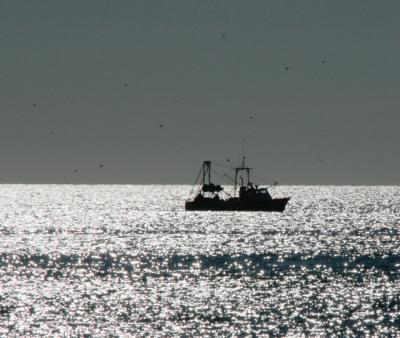Fishermen Assail NOAA’s Quotas

Commercial fishermen on the draggers seen offshore last week took advantage of calmer seas and the State Department of Environmental Conservation’s raising of the daily limit on fluke from 70 to 210 pounds. The higher limit was in effect from Dec. 18 through Friday as the state’s annual quota for the fish, highly sought by commercial and recreational fishermen alike, had not been reached.
Nonetheless, the annual catch limit for the greater Atlantic region, as set by the National Oceanic and Atmospheric Administration, is needlessly small and based, fishermen say, on flawed and outdated data. If NOAA’s recently announced 2017 and 2018 limits are not revised, fishermen will be further restricted with respect to fluke, or summer flounder.
Last Thursday, Senator Charles Schumer called on the United States Department of Commerce to pressure NOAA to conduct a new, science-based assessment of annual quotas for the fish. Mr. Schumer was reacting to NOAA’s release the day before of 2017 and 2018 catch quotas. He called for an updated benchmark assessment to be conducted as soon as possible.
NOAA’s 2017 commercial quota for fluke will be 5.66 million pounds, a figure revised from an earlier 7.91-million-pound limit. The agency, citing declining stocks, also revised its 2018 commercial quota downward. Recreational harvest limits were also revised downward for 2017 and ’18. The 2017 revisions reduce the quota by 29 percent, and the 2018 revisions by 16 percent.
With New York holding just 7.65 percent of the overall mid-Atlantic states’ commercial fluke quota, Mr. Schumer said, these reductions, from 621,244 pounds this year to slightly less than 433,000 pounds in 2017 and barely 288,000 pounds in 2018, “would be devastating to the many communities who rely on this important fishery to survive.”
Mr. Schumer said that the catch limits are based on an outdated benchmark assessment completed in 2013 that must be replaced with one that more accurately reflects the present stock. “These reductions would have a major impact on the livelihoods of many New York fishermen both recreationally and commercially, as well as the shore-side businesses that rely on this important fishery,” he wrote to Kathryn Sullivan, NOAA’s administrator, and Penny Pritzker, secretary of the Department of Commerce. “Therefore, I urge you to revisit and amend the final rule to the current 2016 quota levels until a new summer flounder benchmark assessment is completed, which will help ensure that decisions of this magnitude are based off the best and most up-to-date science,” Mr. Schumer said.
Mr. Schumer called for the 2017 and ’18 quota reductions to be put on hold until a new benchmark assessment has been completed. “The best available science should win the day,” he said in a statement issued last Thursday, “so my argument to the feds is to take a look at the science, update the model, and get 2017 back on the right track for this essential recreational and job-generating Long Island industry.”
Mark Phillips, who fishes on the Illusion out of Greenport, was once among the largest harvesters of fluke in the state, landing a few hundred thousand pounds per year, by his count. Last week, however, he was fishing off North Carolina. Today, “limits are so low that it’s not economical for me to catch New York fluke,” he said. “You can’t target fluke in New York anymore because quotas are so low.”
The problem, Mr. Phillips said, is that stock assessments are inaccurate because NOAA conducts surveys — such as with its ship the Henry B. Bigelow, which collects data in waters from Maine to North Carolina — when fluke are migrating from undersea canyons to inshore waters. “There’s so much fluke in the summer on Georges Bank, it’s unbelievable,” he said of the elevated area of ocean floor that has long supported coastal fisheries in the United States and Canada. “Back in the 1980s, you never saw fluke on Georges Bank; now it’s paved with fluke,” he said. “The population has shifted north and east. . . . Georges Bank is like our beach here. There’s one spot that’s nine feet deep — that’s inshore waters for fluke.”
Bonnie Brady of the Long Island Commercial Fishing Association agreed that NOAA’s trawl surveys are incomplete and therefore producing skewed data. “If it all looks bad,” she said, “it might be because they don’t have enough information.” NOAA, she said, “needs to make decisions based on both fish and fishing communities.”
Next year’s scheduled 30-percent cut in the fluke quota, Mr. Phillips said, “is going to be huge” for commercial fishermen. Officials in NOAA’s Northeast Fisheries Science Center, he charged, “don’t really care about fishermen. All they care about is job security.” What NOAA must do, he said, is “realize their surveys are all screwed up.”
A call seeking comment from NOAA’s sustainable fisheries division had not been returned as of noon yesterday.
